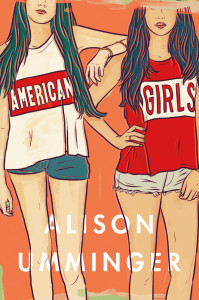 My first Manson girl was Leslie Van Houten, the homecoming princess with the movie-star smile. She was on death row at nineteen for putting a knife into the already-dead body of some poor, random woman for the lamest reason that anyone gives for doing anything: all the other kids were doing it.
My first Manson girl was Leslie Van Houten, the homecoming princess with the movie-star smile. She was on death row at nineteen for putting a knife into the already-dead body of some poor, random woman for the lamest reason that anyone gives for doing anything: all the other kids were doing it.
So begins the young adult novel American Girls by Alison Umminger (Flatiron Books, June 2016).
Fifteen-year-old Anna is carrying a lot of resentment toward her divorced parents, especially her mother who is too caught up in Anna’s baby brother and her own issues to pay much attention to Anna’s needs — at least until Anna engages in some cyber-bullying and gets the wrong kind of her mother’s attention, as well as causes some cracks in Anna’s relationship with her maybe best friend. Now she really can’t stand being at home. So she swipes her stepmother’s credit card and runs away to Los Angeles, where she imagines her half-sister is living a more exciting and Mom-free life. But landing in L.A. only compounds her problems, when her sister is decidedly not happy to see her, but Mom drops a bombshell and then decides she doesn’t want Anna back anytime soon. So Anna is in L.A., but penniless and not exactly wanted. Plus, now she has to figure out a way to earn the money needed to get herself home at the end of the summer. And there’s still schoolwork to do so she doesn’t lose the school year, too, and her friend at home sulking at being abandoned.
Anna’s sister has issues of her own – juggling an ex-boyfriend, a current boyfriend, several secrets, and maybe a stalker, plus her perpetually fledgling acting career. But through her sister, Anna lands a job researching the Manson Family for the ex-boyfriend director, and gets to hang out every day on the set of a popular tween show where the current boyfriend is a writer. And on that set is a hot TV star who might be making eyes at Anna, and his also-famous sister who might be the worst new friend ever.
As Anna researches the Manson Family girls, she starts to draw parallels between the pressures they faced, the reasons they went looking for such a “family,” and how they were treated by the media, with the Hollywood world around her, several of the people she encounters in her real life, and how girls and women in general are judged.
Umminger balances Anna’s immaturity, anger, and insecurities with heavy doses of barbed wit and smart insights into the social trends of the Manson era and today. And through Anna’s insights, Umminger deftly explores themes relevant to teen readers – changing friendships, mistakes and redemption, the pressures placed on girls in our culture and the harsh reactions they confront when they fail to meet expectations, imperfect parents, and that moment some teens face when they realize they have to finish raising themselves.
The parallels between Anna’s feelings of inadequacy and peer pressures and the examples of fame in Anna’s contemporary life, compared to similar themes in Anna’s research about the Manson girls and Sharon Tate, may be especially illuminating and interesting to teen readers. Rich secondary characters are clever archetypes that harken back to significant figures from the Manson era, without any of them feeling cliché or one-dimensional.
Readers looking for a sharp contemporary novel will be drawn into this outsider-inside view of several sides to L.A. culture and the pressures and price of the pursuit of fame. Anna’s Manson Family research makes an interesting bit of awful history relevant. And astute readers will find a smart and skillful exploration of how far – or not – American society has come in terms of defining, confining, and judging girls and women.
* Reviewed from an Advance Reading Copy.